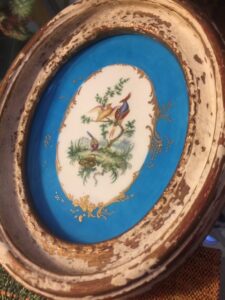 RE loves her blue turquoise oval porcelain dish with images of two exotic birds. She wonders why she likes it so much. MAYBE because of its VAST history, and at one time people considered it rare and valuable. Not today however, when this little plate might, with luck, sell for $150.
RE loves her blue turquoise oval porcelain dish with images of two exotic birds. She wonders why she likes it so much. MAYBE because of its VAST history, and at one time people considered it rare and valuable. Not today however, when this little plate might, with luck, sell for $150.
Back in the 18th and 19th centuries we thought of porcelain as “White Gold.” Why? Because Europeans didn’t discover the secret to making porcelain, on the basic chemical level, until the 18th century. In Persia and China it goes back thousands of years.
What makes something “gold” is WHO wants it, and HOW much they will pay for the product. The nobility of Europe paid a hefty sum for porcelain in those days. Hard to believe today because people don’t want a porcelain table service.
A recent auction comparable sale described RE’s plaque as porcelain of the 18th century, decoration of the 19th century, with an interlace “L” mark to the back. I sent this auction result to RE.
She said “what does that mean?“
That means the designs from the 18th century went into production again in the 19th century, for a PARTICULARLY good reason. Read on!
Let’s go back to the history of Serves, called “the Manufacture Nationale de Sevres, Haute de Seine,” founded by a company in Vincennes in 1740. The French Crown took notice of that small factory and ordered it moved to Serves and bought it in 1759. The Crown became interested in only what made the Crown money and gained the Crown prestige.
In 1710 Augustus the Strong (King of Saxony) hired the brilliant chemist Bolger to figure out HOW Asians made porcelain. Bolger re-discovered hard paste porcelain, where deep heat firing makes it impervious to heat and able to glaze. When France, always a rival to Germany as regards TASTE, heard about this, chemists alerted Louis XV who BOUGHT a lab/factory in France and urged further discoveries. Sevres of this period bear the double “L” mark for Louis. The first international spies lurked around the German factory, trying to purloin secrets of porcelain and bring those chemical analyses back to France.
White Gold in FRANCE
Discovery of Kaolin in the area around Limoges hastened the development of White Gold in FRANCE. Louis purchased those Kaolin quarries. All the heads of State wanted porcelain for their table, for their display halls. What our KIDS do not want today, they wanted in the 18th century!
Louis hired the best painters, gilders, and chemists to make French porcelain the BEST in the world. In fact the French Académie des Sciences said that in 1769 France had perfected hard paste porcelain. True, of course, but a thousand years previously so did CHINA.
Serves porcelain became so popular that George IV Queen’s Gallery in Buckingham owns the largest collection of Serves in the world.
The aftermath of the French Revolution and Louis XVI‘s execution saw the birth of the French Republic. That Republic rebranded Sevres Porcelain “RF Serves.” Lucien Bonaparte ruled in 1800 and his Uncle Napoleon and wife Josephine loved porcelain, so in the dawn of the 19th century, Sevres was made in the OLD style for the New Republic. After Napoleon fell in 1815, Lois XVIII came to rule France, because he was a conservative, and a Crowned Royal Prince, Louis XVIII ordered reproductions of the 18th century motifs dear to Louis XVI. He showed the reproductions of the old styles regularly at the Louvre.
Another Prince, Louis Phillip (1830-1848), continued in this conservative tradition until France went through yet another revolution (1848) and Napoleon the Third took the throne (Napoleon’s nephew) and reigned from 1852-1870. They referred to this as the Second Republic, and because it was the Second of one of Napoleon’s heirs becoming rulers of France, the style of the First Republic was brought back by Napoleon III’s wife Empresses Eugenie, who adored OLD traditional Serves porcelain.
Hard to understand today because we don’t treasure this style, but for two hundred years indeed Serves was White Gold.
What a cool column on porcelain… gee all of us who love it are only 3 centuries late? 😆.
That and the ‘purloin of porcelain’ secrets. Sounds like a serial from silent film.
Pingback: Small Plates Tell a Story - Elizabeth Appraisals